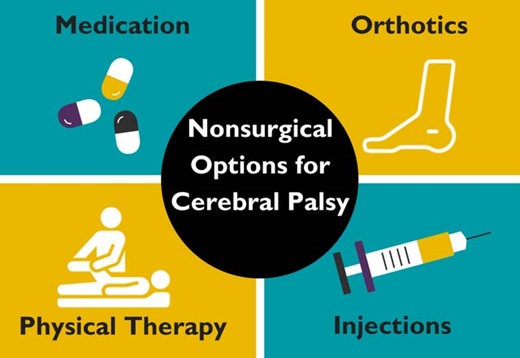Cerebral Palsy: 4 Treatments to Try Before Surgery
Reviewed By:
“Is this treatment right for my child?” This is a question parents of children with cerebral palsy (CP) grapple with daily. It can be especially scary when the treatment you’re considering is surgery.
Surgery can be an effective, long-lasting treatment for children with spasticity (muscle stiffness) due to CP. Surgery may also be an option for symptoms of dystonia (abnormal muscle movement associated with painful muscle spasms), which can occur with CP.
However, Johns Hopkins pediatric neurosurgeon Shenandoah “Dody” Robinson, M.D ., always tries less invasive treatment options first. These nonsurgical treatment options include:

Physical Therapy
Physical and occupational therapies help improve symptoms for many children as young as infants up through grade school.
Orthotic Devices
If physical therapy is not enough, a rehabilitation specialist or orthopaedic doctor may recommend your child use a brace or other orthotic device. These devices make moving much easier and allow children with cerebral palsy to be more independent.
Oral Medication
Your doctor may prescribe an oral medication such as diazepam or baclofen, which help relax the muscles. They can be given through a feeding tube, if your child has problems swallowing.
Because these medications travel through the bloodstream, sometimes they can cause unwanted side effects, such as making your child sleepy or dizzy. Your doctor can help you decide whether the potential benefits of medications outweigh their risks.
Muscle Injections
Muscle injections that are delivered to an arm or leg, for example, can also help some children with CP. Your doctor will determine how much medicine to give based on how much your child weighs and other factors.
While injections are a safe treatment, the results often last for weeks to months. Repeated injections are necessary for continued effect.
When is surgery an option for cerebral palsy?
If a child has tried all of these treatments but is not experiencing sufficient relief, Robinson considers whether surgery is the logical next step. Two neurosurgeries that she has had much success with in recent years are:
- Selective dorsal rhizotomy: In this surgery, surgeons work to improve the communication lines between the spinal nerves and muscles by testing and cutting abnormal “rootlets” under the microscope with intraopertative monitoring.
- Intrathecal baclofen pump: An intrathecal pump is surgically placed inside your child’s abdominal wall. The pump delivers medication directly to the spinal fluid, which increases symptom relief.
Remember, always speak with a knowledgeable physician when considering treatment.






